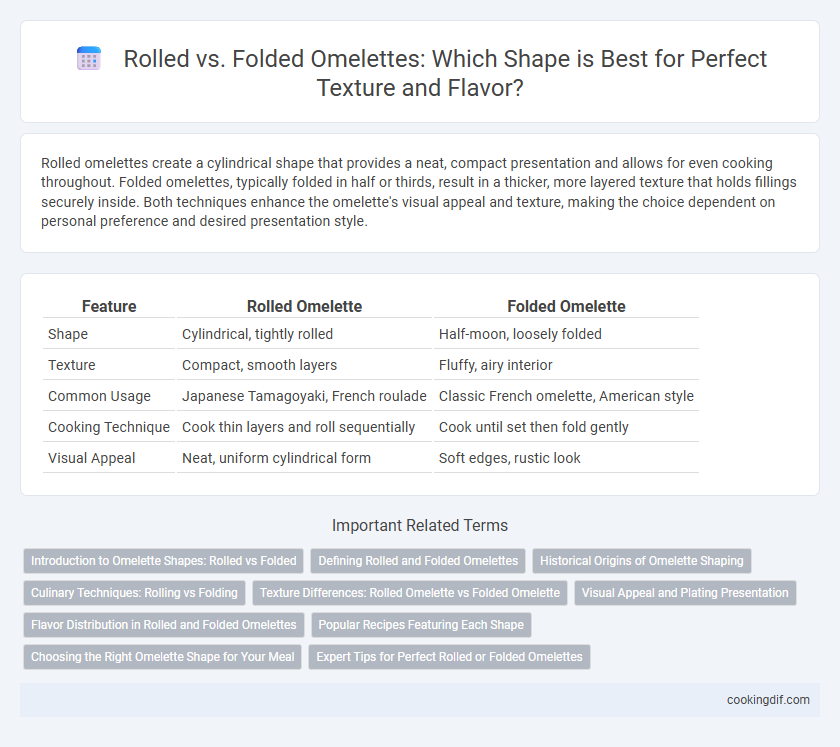Rolled omelettes create a cylindrical shape that provides a neat, compact presentation and allows for even cooking throughout. Folded omelettes, typically folded in half or thirds, result in a thicker, more layered texture that holds fillings securely inside. Both techniques enhance the omelette's visual appeal and texture, making the choice dependent on personal preference and desired presentation style.
Table of Comparison
| Feature | Rolled Omelette | Folded Omelette |
|---|---|---|
| Shape | Cylindrical, tightly rolled | Half-moon, loosely folded |
| Texture | Compact, smooth layers | Fluffy, airy interior |
| Common Usage | Japanese Tamagoyaki, French roulade | Classic French omelette, American style |
| Cooking Technique | Cook thin layers and roll sequentially | Cook until set then fold gently |
| Visual Appeal | Neat, uniform cylindrical form | Soft edges, rustic look |
Introduction to Omelette Shapes: Rolled vs Folded
Rolled omelettes feature a smooth cylindrical shape achieved by carefully rolling the cooked egg layer, offering a neat presentation often used in Japanese tamagoyaki. Folded omelettes create a half-moon or crescent shape by folding the egg over itself, retaining a fluffy texture and allowing fillings to be enclosed easily. Both techniques influence texture and visual appeal, with rolled omelettes emphasizing uniform layers and folded omelettes showcasing a more rustic, airy structure.
Defining Rolled and Folded Omelettes
Rolled omelettes are characterized by their long, cylindrical shape created by rolling the cooked eggs around fillings like cheese or vegetables, often seen in Japanese tamagoyaki. Folded omelettes have a semicircular or crescent shape formed by folding the cooked egg over the filling, typical of French-style omelettes. The defining difference lies in the technique: rolling involves multiple layers wrapped tightly, while folding results in a single, thicker layer enclosing the ingredients.
Historical Origins of Omelette Shaping
Rolled omelettes trace their origins to Japanese tamagoyaki, where thin layers are carefully folded and rolled to create a cylindrical shape, reflecting meticulous culinary techniques developed centuries ago. Folded omelettes, common in French cuisine such as the classic omelette nature, emphasize a gentle fold to encase fillings, originating from European cooking traditions focused on texture and presentation. These distinct shaping methods highlight cultural approaches to texture, flavor integration, and aesthetic presentation rooted in historical culinary practices.
Culinary Techniques: Rolling vs Folding
Rolled omelettes create a smooth, cylindrical shape by gently rolling the egg mixture over fillings, preserving even cooking and a delicate texture. Folded omelettes involve lifting one side of the cooked egg and folding it over the other, resulting in a layered, thicker appearance that traps fillings inside. Mastery of rolling versus folding influences presentation and texture, making these techniques essential skills in culinary arts.
Texture Differences: Rolled Omelette vs Folded Omelette
Rolled omelettes feature a smooth, uniform texture with softly layered curds that create a tender bite, while folded omelettes have a slightly denser interior with varied curd sizes offering a more rustic mouthfeel. The rolling technique preserves moisture and results in a delicate, custard-like consistency, whereas folding allows for a firmer structure with a slight crispness on the edges. Texture differences significantly impact the eating experience, where rolled omelettes provide a silkier sensation compared to the more substantial chew of folded omelettes.
Visual Appeal and Plating Presentation
Rolled omelettes create a sleek, cylindrical shape that enhances visual appeal through smooth, uniform layers, making them ideal for refined plating presentations. Folded omelettes offer a rustic, textured appearance with visible fillings, adding a homey charm that complements casual or hearty dishes. The choice between rolled and folded shapes significantly influences the overall aesthetic, balancing elegance with warmth to suit different culinary styles.
Flavor Distribution in Rolled and Folded Omelettes
Rolled omelettes create even flavor distribution by layering ingredients throughout each bite, allowing fillings like cheese and herbs to blend seamlessly with the eggs. Folded omelettes tend to concentrate flavors in specific sections, often resulting in a more intense taste burst where fillings are wrapped inside. The choice between rolled and folded shapes directly impacts how consistently flavors are experienced across the omelette.
Popular Recipes Featuring Each Shape
Rolled omelettes, common in Japanese Tamagoyaki, create a uniform cylindrical shape ideal for slicing into bite-sized pieces, popular in sushi and bento boxes. Folded omelettes, seen in French-style omelettes, display a soft, airy texture with filled ingredients tucked inside, often served as a delicate brunch dish. Both shapes inspire diverse recipes, with rolled versions emphasizing neat presentation and folded versions focusing on creamy fillings and rustic appeal.
Choosing the Right Omelette Shape for Your Meal
Rolled omelettes offer a sleek, cylindrical shape that holds fillings tightly, ideal for packed lunches or elegant presentations. Folded omelettes create a crescent shape with a fluffy interior, perfect for showcasing ingredients and offering a lighter texture. Selecting the right omelette shape depends on the desired presentation, texture, and how the fillings are incorporated into your meal.
Expert Tips for Perfect Rolled or Folded Omelettes
Expert tips for perfect rolled or folded omelettes emphasize using non-stick pans heated to medium-low for even cooking without browning. Rolling omelettes requires starting with a thin layer of egg, allowing partial set before carefully rolling with a spatula, ensuring a smooth, cylindrical shape. For folded omelettes, gently lift one edge and fold it over the filling, maintaining a soft, tender texture by avoiding overcooking.
Rolled vs folded for shape Infographic

 cookingdif.com
cookingdif.com